SAP is one of the biggest names, if not THE biggest name in the predictive data analytics industry. It is especially a major player in sports and entertainment around the world, focused on creating all-new experiences for fans and simplifying processes at the highest levels for teams, leagues, and event venues in basketball, sailing, tennis, soccer, and more – including equestrian sports.
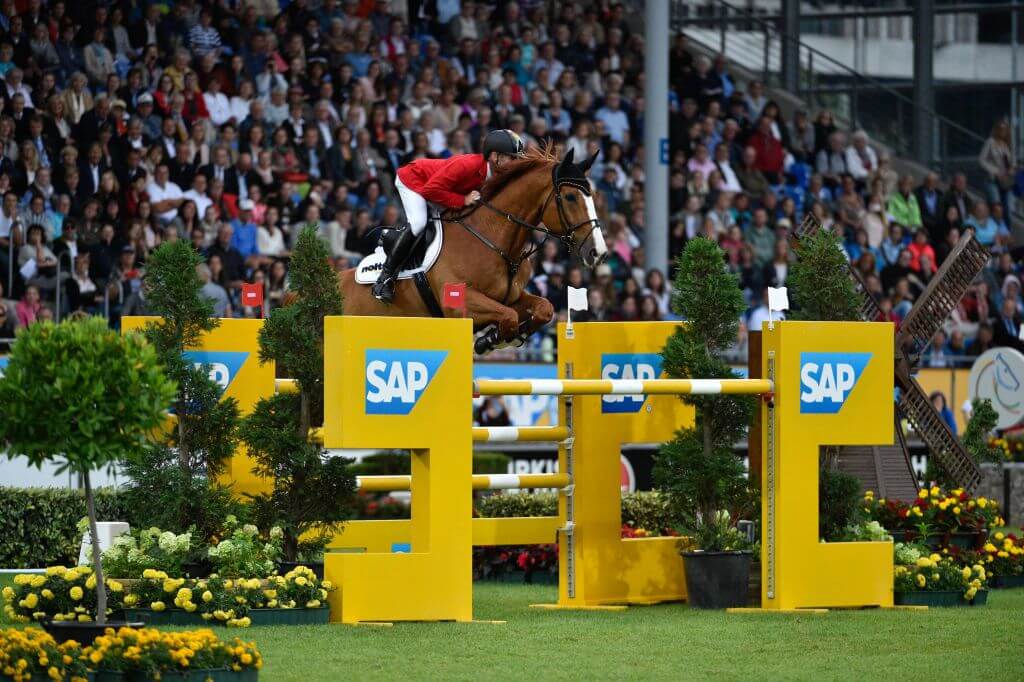 Photo by Davide Mombelli / Getty Images.
Photo by Davide Mombelli / Getty Images.
SAP supports riding in particular because of its unique characteristics: Both men and women compete on equal terms. A sport unlike any other, that has an incredibly unique partnership between horse and rider. SAP has provided integrative solutions for spectators, fans, and riders themselves to participate in their own predictive and comparative performance scoring as they watch world-class events live, becoming an integral part of the action.
SAP is well-known in the eventing and dressage worlds, as it has partnered with EquiRatings to provide predictive scoring apps for fans in incredible apps like Eventing Manager and the Predictive Analytics Center. It also has partnered with CHIO Aachen, Event Rider Masters, the FEI (FEI’s Official Analytics Partner), and Black Horse One. However, to the hunter/jumper world, SAP is less well-known. It has further emerged and drawn light to its technological achievements with the launch of its newest initiative, the #ridersconnected initiative. Sparked by COVID-19 and the resulting isolation of us all, SAP endeavored to create a community online where equestrian riders, friends, and fans could feel safe, supported, and together while still physically being apart. A large growth was sparked organically without any sort of major marketing campaign. The hashtag #ridersconnected draws posts to the social wall on the Riders Connected hub, and blogs and videos are updated from professionals, including SAP Ambassador Ingrid Klimke. Riders Connected is both creating further solidarity and shedding more light on the beauty of SAP’s new technologies and what they can do for our sport.
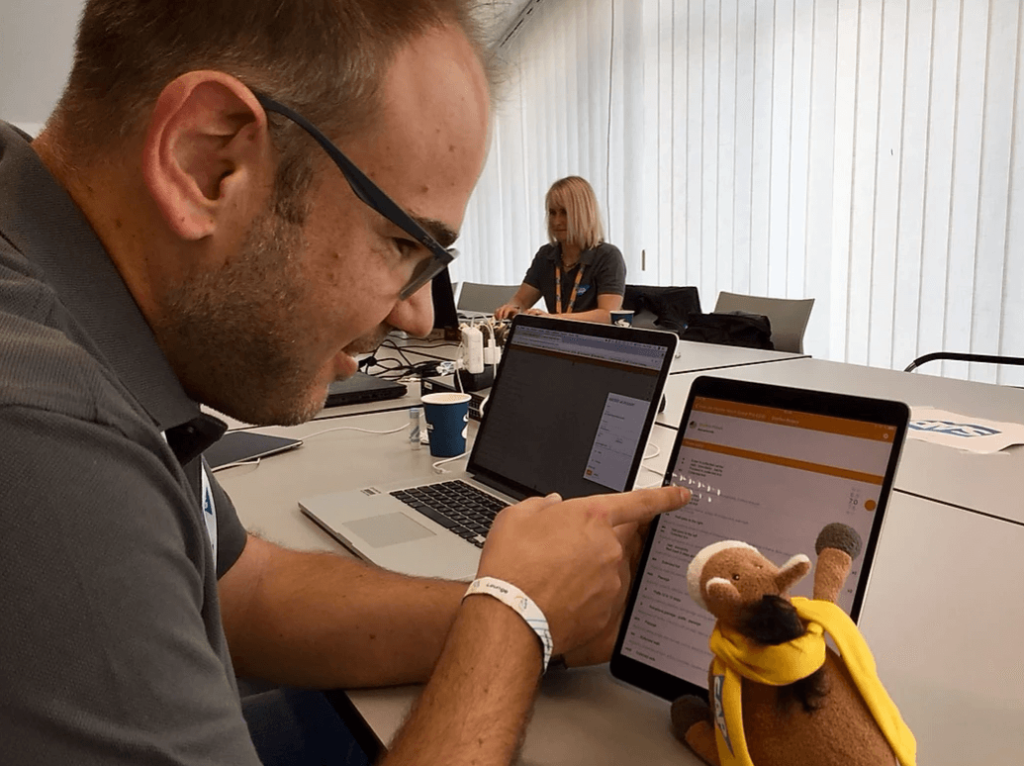 Hard at work with charity partner Wilberry Wonder Pony! Photo by SAP.
Hard at work with charity partner Wilberry Wonder Pony! Photo by SAP.
Lynn Mueller and Dominique Gonzales from the Jumper Nation team sat down with Henrike Paetz, the Head of Equestrian Program at SAP to learn more about SAP’s equestrian division, Riders Connected, and how it may delve further into pure show jumping.
Jumper Nation: When did SAP first begin to conceptualize an equestrian division specifically, rather than incorporating it into its more general sports division?
SAP: The Equestrian Sports Sponsorship Program is part of SAP’s Global Sponsorship portfolio. It was started with the announcement of the CHIO Aachen partnership in 2013. Equestrian sports offer a set of unique characteristics that SAP values and is proud to support. Among these are the strong diversity aspect with men and women competing at equal terms and until old age, a very high percentage of female fans and athletes, and the unique partnership aspect between rider and horse demanding both a lot of physical skills but also sensitivity and emphatic leadership from the athletes.
Some disciplines, like dressage, require a high level of expert knowledge from the spectators to be able to understand the scores, and others – like Eventing, the equestrian triathlon – often pose a challenge to follow and understand the action on the courses. Event organizers are eager to help the fans get better insights and become an integral part of the action. Over the last couple of years, SAP has provided innovative solutions to help the audience experience the sport much better and get involved in completely new ways – both onsite and from home. Media is supported with new tools and assets to engage viewers through a better storytelling based on more results, stats and predictions in real-time. Athletes benefit from new performance observations with state-of-the-art technology.
JN: How do you anticipate growth in the equestrian division to change over time? With COVID-19 still being active, do you anticipate that this will actually increase the need for predictive analytics as both a measure to increase spectator enjoyment and attendance (if possible) at competitions, or to assist competition organizers in proving that they’re taking active steps to manage risk?
SAP: The use of predictive analytics has increased enormously in equestrian sports over the last five years, primarily due to the work of our partner EquiRatings. Their team of data scientists and analysts are clearly strong at conducting the analysis but critically for us, they make the information accessible and use the data to tell stories. In that sense, the use of data analytics goes beyond spectator enjoyment, competition organizers or risk management and across almost any aspect of the sports which can be measured. Once it can be measured, it can be managed and improved. Based on what has happened in all the professional sports and also in entertainment, I do see it continuing to grow, but not necessarily as a result of this crisis.
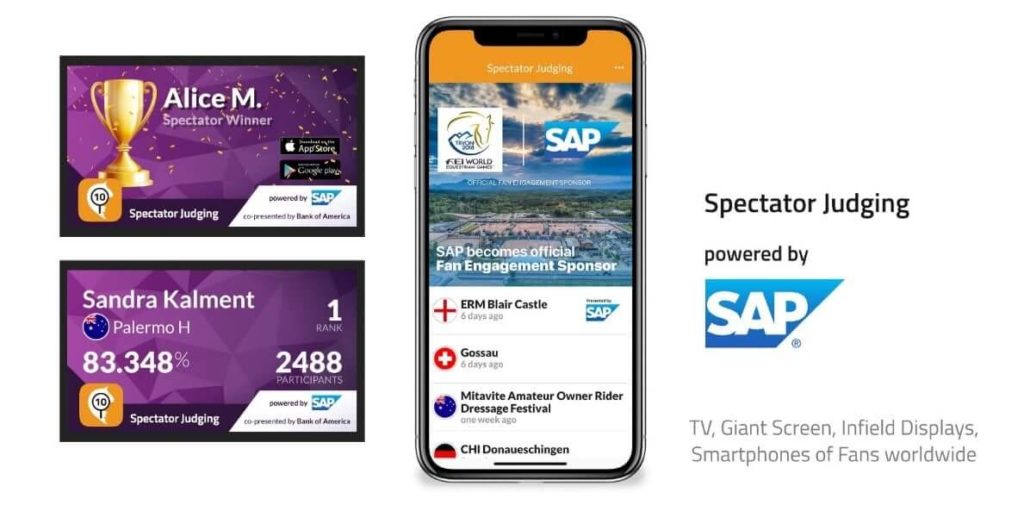 An example of the Spectator Judging app. Spectator scores are shown on a large screen in the arena. Photo by SAP.
An example of the Spectator Judging app. Spectator scores are shown on a large screen in the arena. Photo by SAP.
JN: Does SAP have future plans for predictive analytics and data analytics in pure show jumping? I could see how this may be more difficult to calculate since scores aren’t cumulative over a period of days like with eventing (dressage score + cross country + stadium), and some classes involve riders going right from the course to the jump off [tables 2(b) and 2(c) versus having a call back (table 2(a)]. Perhaps this would work for international show jumping [table 2(a)].
SAP: We are absolutely interested in all of the Olympic level equestrian sports and while we worked closely with EquiRatings in eventing, we have also worked closely with Black Horse One who have revolutionised how dressage is scored and how fans of that sport can engage with it. We have looked at different fan engagement options in show jumping and have trialed different offerings with our key partner – CHIO Aachen. In relation to the use of predictive technology, we do envisage that through our partners, we will have further offerings in this area. As you note, the basis of the sport is not the same as eventing but there remain many aspects of the sport which can be measured and improved. There are also many more fan engagement offerings to bring the show jumping fans closer to the sport they love.
JN: Do you think breeding information would be an additional item of importance to include as an additional implement to EquiRatings? This could possibly be of use to fans looking for more detailed information on a particular horse, or even to purchase it.
SAP: This information would certainly be useful for existing fans, but it may be too detailed for new fans who are just learning the sport for the first time. We want to be able to help both existing and new fans for all to enjoy the sport.
JN: With dressage being partially subjective in scoring, it certainly helps as far as fans are able to see how their own scoring stacks up against the judges’ scores — how does this fall into play in terms of “official” predictions? For example, if we look at NFL announcers predicting which team will win in the Super Bowl, they don’t typically mention fan predictions — but for more fan engagement, this could be interesting information to include.
SAP: The increased use of fan feedback is something we are proud of and hugely supportive of. Essentially the inclusion of the fan prediction (Black Horse One) working alongside the official prediction (EquiRatings), both working alongside the actual performance, is a big part of how SAP brings its partners together to maximise the experience of equestrian fans.
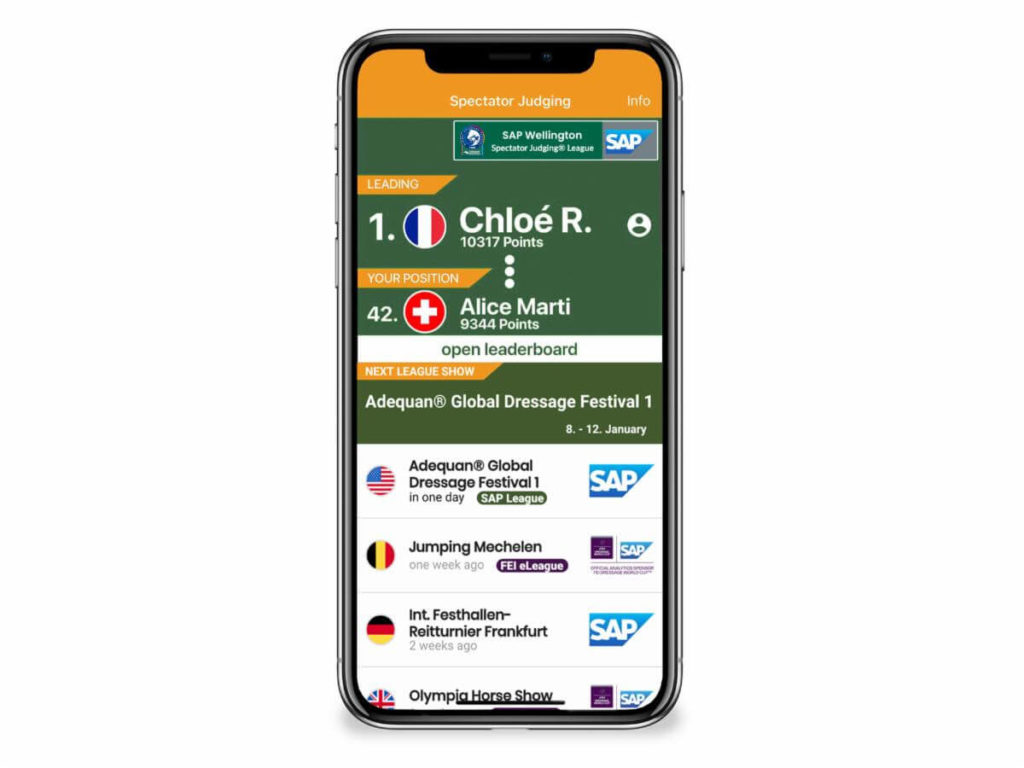
An example of SAP’s technology as used for pure dressage. Photo by SAP.
JN: Regarding the Riders Connected initiative, do you plan on adding additional professionals or successful amateurs from pure dressage or show jumping to promote the campaign and social/video walls? I ask this because the jumper community is even larger than the eventing community, with over 44,000 members in the USHJA compared to the USEA’s 13,000. We have an enormous number of potential riders who could benefit from both the data and the Riders Connected platform.
SAP: Riders Connected is absolutely intending to reach beyond the eventing community. The campaign started in a very real and organic way. We normally meet our partners at events across the year and in 2020, it looks as though that is not going to be possible. This felt like a problem for a wider group and the shows really are the glue which ties together our community – a community which includes volunteers, commentators, media, judges, owners, scoring teams, sponsors and many more. The campaign is about giving people a base, a home, while we are without the normal mechanisms for staying in touch. The dressage community and jumping communities will feel similar, and if we can help in any way to bring them closer, it feels like the campaign will be serving its purpose – even without actively pushing for participants.
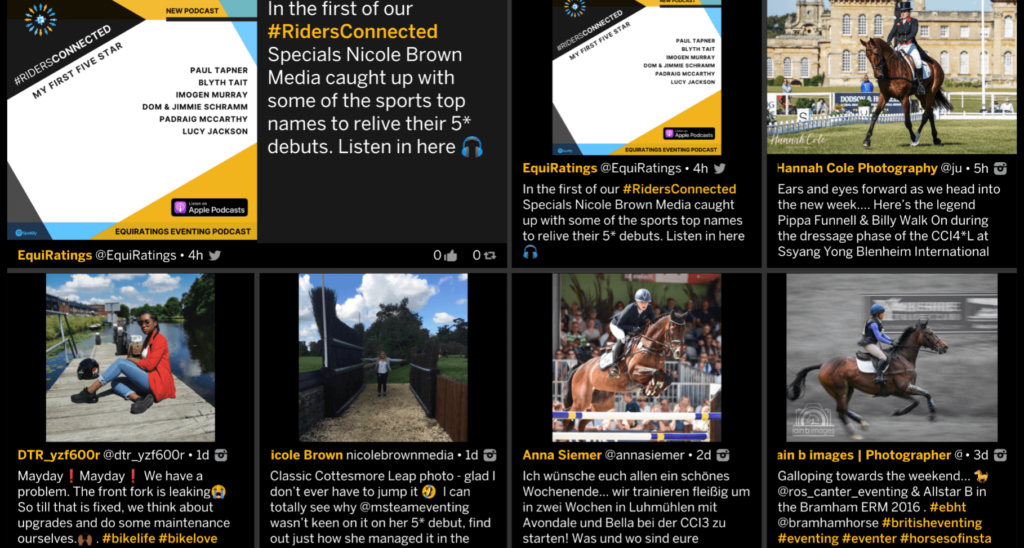 The Social Wall on the Riders Connected platform. Photo by SAP.
The Social Wall on the Riders Connected platform. Photo by SAP.
JN: The jumper community at times seems less connected in so far as having a solid community like eventers do, where pros will often help out even tadpole event riders at shows. With the work we’ve been doing of late at Jumper Nation by beginning to address more controversial topics, such as the lack of technology at shows (ie, physically having to check in at the ring), we’re beginning to draw people together in conversation and bring them out of the woodwork. What are your thoughts on this?
SAP: The eventing community has always been hugely supportive, both of what we are trying to achieve with technology and also of each other. That makes it an easy place to start but as you note, riders from all the disciplines are seeking connection, advice, feedback and learning. That’s something we want to support.
JN: What were some of the priorities on your wish list when developing the Riders Connected platform? For example, was it more important to create blog articles first to be very personable, or create straight social media posts to begin getting the hashtag out in “the wild”?
SAP: Our first priority was to support our partner’s desire to ‘do something’ when we all found ourselves quite rudderless at the start of this crisis. We feel very lucky to work with so many good partners, who each bring different strengths. This includes riders like Ingrid Klimke, events like CHIO Aachen, a series like the Event Rider Masters, a charity – Hannah’s Wilberry Wonder Pony and of course, EquiRatings and Black Horse One. All of them wanted to help and support the community in some way, so our priority was to bring them together and see where they could take it.
In terms of the approach, there was a strong desire that the campaign would never be a marketing exercise and would grow naturally. In that sense, we have not focused on promotion or any normal marketing push. It has been grown by the people who it is intended to serve, which is something we are really proud of.
JN: Do you typically see reader engagement ebb and flow with the Riders Connected platform, or does it remain fairly steady, especially now with shows starting again?
SAP: We will often see a spike on the website when we add articles, interviews or a new feature but really the website is only a jumping off point. The hashtag itself and the concept have grown far beyond anything we can track. It is a reminder that on the day you feel disconnected or disillusioned, we are all here together as a community. On the basis that we have all felt like that on different days, and likely will for some time yet, the traffic slow has been pretty steady.
JN: When we look at addressing risk by helping clients see quantifiable metrics regarding factors such as speed limits, or even in general (is one particular event more “risky” than another), do you see this eventually possibly reducing the amount of insurance that a client may need to carry in order to host an event, if concrete risk management measures and metrics can be presented to the carrier?
SAP: At SAP, our technology and our work with partners has been more fan-focused. Some of our partners work directly with their clients on these types of questions, but it has not been something we have sought to be involved in.
 Photo by SAP.
Photo by SAP.
JN: Typically, your team would be attending events in person, though with COVID-19, this looks unlikely to happen in 2020. However, though there is currently a rise in virtual events and virtual vending, do you still anticipate attending in 2021 (providing this is permitted by various shows)?
SAP: Yes, and we are looking forward to it!
Editor’s Note: Questions and responses have been edited for clarity.
